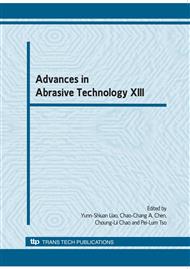p.415
p.423
p.429
p.435
p.441
p.447
p.457
p.463
p.469
Odor Suppression of Putrid Water-Soluble Coolant Using Home Ion Generator
Abstract:
This paper deals with a technique to easily suppress bad odor of water-soluble coolant (working fluid) by using a commercially available ion generator for home use. At the shop floor, water-soluble coolant is in heavy use, where putrid bad odor is apt to be generated from water since over 95% of the coolant component is water, leading to a short life of the coolant. Expecting an effect of suppressing putrid odor of water-soluble coolant, application of ion mixed air using an ion generator for house use was examined. As a result, bubbling with ion mixed air could achieve a drastic suppression of a bad odor generated from putrid water-soluble coolant, compared to a bubbling with air only. In addition, it was confirmed that by discharging ions into a machine emitting a bad odor, the odor level decreases drastically. From these results, a machine having an ion generator built-in can be proposed as an environmentally friendly machine tool.
Info:
Periodical:
Pages:
441-446
Citation:
Online since:
August 2010
Price:
Сopyright:
© 2010 Trans Tech Publications Ltd. All Rights Reserved
Share:
Citation:


